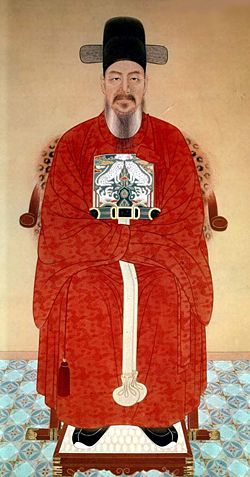Yi Sunshin
Yi Sunshin[1] (이순신:李舜臣, April 28, 1545 – December 16, 1598) was a Korean admiral renowned for his naval victories against the invading Japanese during the Korean War of 1592-1598.
Family & early life
Yi Sunshin was born on April 28, 1545 in the Geoncheon-dong area of Seoul. Yi was the third child of the four sons begot by Yi Jeong[2] and Chogyae Byeonssi.[3][4] Despite their aristocratic yangban lineage, the family lived a modest life, since Yi's father opted to avoid pursuing the promising path of a Joseon Dynasty scholar official. The reason for this withdrawal of ambitions was Jeong's unpleasant memory of a violent political purge 20 years before, in which many government officials were killed, and many others, including Sunshin's grandfather, Yi Baek-rok,[5] were demoted to the lower ranks.[6][7]
The eldest son of the family was Heuishin[8]; the second eldest, Yoshin (요신:堯臣); and the youngest, Ushin (우신:禹臣). When Chogyae Byeonssi was pregnant with her third child, Yi Baek-rok, who was now deceased, appeared to her in a dream and said, "that child will turn out to be extraordinary, so name him 'Sunshin'."[9] Thus, like his brothers, Yi Sunshin was named a "vassal" (shin) of one of the sage kings of ancient China (in his case, Shun).[10][11]
Not much is known about Yi's early life. The only significant detail regarding the time he grew up in Seoul is that he became friends with Yu Seongnyong (유성룡:柳成龍), who later would become a high ranking scholar official and contribute to Yi's appointment to admiralty.[11] After about 9 years in the capital city, Yi Sunshin followed his family to the Bam-bat-ma-eul village in Asan,[12] where their economic hardships could be better managed with support from their relatives on the mother's side.[13]
Yi was said to be well liked by the other children in the neighborhood despite his being a newcomer. Among the various fun activities that Yi and his friends pursued were the war games, in which Yi was consistently picked as a captain.[10] Yi also carried bow and arrows around freely and enjoyed practicing archery. These boyish interests were rather a fitting contrast to his strict rearing at home, where Yi studied Chinese classics with his brothers.[13]
When Yi was around 20 years old,[14] he married Sangju Bangssi (상주방씨:尙州方氏), who was the only offspring of Sangju Bangjin (상주방진:尙州方震), a high-ranking officer in the military.[15] After the marriage, when Bangjin made it known that Yi had potential in the military profession, Yi quit his Confucian studies and committed himself to the military curriculum.[16] Yi formally began training for the military examination in October, 1566, at the age of 21. During the 6 years that Yi trained, he fathered 2 sons: his first son, Yi Hwae (이회:李會), in February, 1567, and Yi Ull (이울:李蔚) during the war with Japan, who would be renamed by his father as Yi Yer (이열:李悅), in February, 1571.[12]
A survey conducted by Sooncheonhyang University in 2005 indicated that Koreans in general regard Yi Sunshin to be the greatest figure in Korean history.[17]
notes
- ↑ Note 1: For Korean names, the western equivalent of the last name comes first, and the first name comes last. There is no middle name in Korean - "Sun" is not a middle name. Note 2: Yi is correctly pronounced as "Eee"/"Ii".
- ↑ Note: 이정:李貞 (Korean:Chinese)
- ↑ Note: 초계변씨:草溪卞氏 (Korean/Chinese)
- ↑ Note: Korean women keep their last name upon marriage
- ↑ Note: 이백록:李百祿 (Korean/Chinese)
- ↑ 선비가문, 지혜에 담력 갖춘 지장: 이순신과 임진왜란의 재조명 by Yi Naewon, Washington Hangook Ilbo, 2003-04-29, date accessed: 2008-07-27
- ↑ 기묘사화 (己卯士禍), Korea Britannica Encyclopedia, Daum.net, date accessed: 2008-07-27
- ↑ Note: 희신:羲臣 (Korean/Chinese)
- ↑ 이순신의 탄생과, 그 무렵의 국내 정세, 성웅 이순신 project, Asan municipal government, date accessed: 2008-07-27.
- ↑ 10.0 10.1 소년시절, 성웅 이순신 project, Asan municipal government, date accessed: 2008-07-28.
- ↑ 11.0 11.1 Hawley, 2005. pp. 118-122.
- ↑ 12.0 12.1 연대표, 성웅 이순신 project, Asan municipal government, date accessed: 2008-07-28.
- ↑ 13.0 13.1 '제 2의 고향', 아산, 성웅 이순신 project, Asan municipal government, date accessed: 2008-07-28.
- ↑ Note: In Korean customs, a person is already one year old at birth. Therefore, Korean sources actually say that Yi was 21 when he married.
- ↑ 이순신, Korea Britannica Encyclopedia, Daum.net, date accessed: 2008-07-28
- ↑ 명장의 자질을 읽은 방진, 성웅 이순신 project, Asan municipal government, date accessed: 2008-07-28.
- ↑ Citizens Name Admiral Yi 'Greatest Korean', Chosun Ilbo, 2005-04-15, date-accessed: 2008-07-24
